We enjoyed our tour with Abel so much on the first day that we agreed to hire him for a second day to tour the newer part of the city if he could find us a pink convertible for our ride. (This was a "must do" on Linda's checklist for our visit.)
"No problem. We'll pick you up at 10:00 A.M.," he replied.
When we walked out of the B&B the next morning, there it was: The longest and brightest pink Chrysler Imperial you can imagine.

"1958?," I asked - It had dual headlights.
"1957," replied the driver.
My mistake. It turns out that there were a few cars made with dual headlights in 1957 - they didn't become legal in all 48 states until 1958 and manufacturers like Chrysler that were leading the way on this fashionable new trend, had a battle to fight implementing "all quads."
We proceeded to spend three hours visiting several locations in the new part of town, then visited the hill opposite Old Havana where the statue of Christ watches over the city before we returned to our B&B. Here are the locations we'll see.
Red arrows, clockwise from left to right:
5th Avenue and Embassy Row in Miramar
The Malecón esplanade
Revolution Square
Hotel Nationale de Cuba
Máximo Gómez Monument
Christ of Havana
The pink area is Old Havana, described in the previous post. We began by heading west toward Revolution Square. Our route took us past a mixture of old and new as we made a few turns to take in some cultural highlights.
We traveled about two miles along Simon Bolivar after leaving Old Havana. We passed Palacio Central de la Computación y la Electrónica, (the Central Palace of Computing and Electronics) which was dedicated some thirty one years ago by Fidel Castro himself to offer services and education in the computer and communications field.

There was quite a mix of old and new along the route. Up ahead we caught a glimpse of Iglesia Del Sagrado Corazon de Jesus y San Ignacio de Loyola (Church of the Sacred Heart of Jesus and Saint Ignatius of Loyola) surrounded by scaffolding as it undergoes restoration. Across the street is the huge Masonic Grand Lodge. Curiously, Cuba has over three hundred Masonic Lodges. I say curiously, since most Communist countries outlawed them.
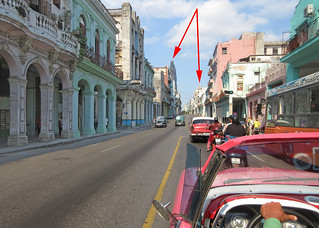

We took a slight detour off a straight line path to Revolution Square in order to pass by the University of Havana. Doing so we passed by the beautiful bell tower of another Catholic church, Iglesia y Convento de Nuestra Señora del Carmen (Church and Convent of Our Lady of Mount Carmel) which is topped off by a beautiful statue.
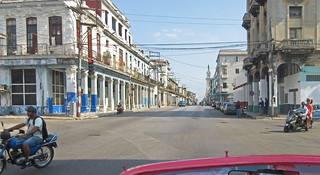

The University of Havana presented a marvelous front to the street as we drove by. The University has somewhere between 24,000 and 60,000 students (both numbers come from the same Wikipedia article) or maybe 38,000 as the University's own website claims.


As we turned the corner heading back toward Revolution Square, we passed the most famous of Cuba's movie theaters, the Yara. This theater opened in 1947 (some sources say early 1950s) and is Cuba's second largest. Cuba once had 600 movie theaters on the island and 147 in Havana alone. More than 80 percent are gone now. One local cinema buff has devoted time to recording the theater scene and has a story here.
As we drove by, I noticed that two movies were playing that day including one from Estados Unidos - Avatar, el Camino del Agua (Avatar, the Way of Water.)


Reaching Revolution Square, or Plaza de la Revolución as it is know here, we were greeted by the towering (358 feet high) monument to José Martí, "Apostle of Independence," whom we met in the previous post. While the design dates from 1939, construction was not completed until 1958. The monument story, in full, can be found at Wikipedia. There is an observation gallery at the top, which we did not visit. A 59 foot tall statue of Martí is positioned at the bottom of the monument.


Opposite the Martí monument you can see the iconic portraits of Che Guevara and Camilo Cienfuegos high on two of the government and Communist Party headquarters buildings that adjoin the the Plaza. Guevara is outlined in iron on the Ministry of the Interior and Cienfuegos on the Ministry of Information and Communications.
The two buildings with the portraits have that certain "Soviet" appearance that reminds us of the Mogamma in Cairo. Incidentally, there are numerous apartment buildings in Havana that strongly resemble the buildings in Moscow known informally as "Khrushchevs."
Our next stop on the tour was at the site of a 300 year old banyan tree. This was located at Parque Almendares, an urban oasis, that is also well known for the Piña Coladas conveniently mixed at a stand beside the parking lot. Virgin Coladas are available as well.
And, speaking of the parking lot, it collects a great many of Havana's old cars, all with tourists headed for either the Banyan tree, or the Piña Coladas. That's our pink convertible right in the middle of the lot.

From the park, we drove over to 5th Avenue and "embassy row" in the Miramar district. In years now long passed, Miramar was a fashionable new district of Havana inhabited by the wealthy. After the revolution in 1959 when these homes were confiscated and "redistributed," some of these properties became government buildings and many became embassies. The drive down 5th Avenue (once know as Avenue of the Americas) in Havana still provides a glimpse into a different era.


We now headed back to the east, turning onto the Malecón, a broad esplanade and seawall stretching some five miles along the ocean front. There were occasional fishermen and groups of locals just enjoying the day.

We were headed for the famous Hotel National, but first we passed by the massive 39-story residence know as the FOCSA building. Built in 1952-54, at the time it was reportedly the second highest concrete and steel building of the world.

We pulled up into the parking lot of the Hotel Nacional de Cuba and walked in through its Palladian style entrance portico. Built in 1930, the hotel has quite an unusual history including a bloody siege in 1933 between two army factions that left 40 dead and a 1946 crime-family conference with many names recognizable to readers/viewers of The Godfather.
With an enviable roster of entertainers during the 1950s, the National was "the place" to stay in Havana at the time. There are numerous photos of U.S. entertainers on display including Nat King Cole who was denied lodging in the hotel in 1956. Famed Cuban singer, Compay Segundo - "the man with the hat" is honored with a life-size statue.




We walked out onto the terrace behind the Hotel National to look at the beautiful view of the Caribbean. Not far beyond the hotel property is a twin-column monument honoring the 266 U.S. Navy men who died when the American battleship USS Maine sank after an explosion in the Havana harbor in 1895. With headlines in the Hearst papers and others of "Remember the Maine," the United States then entered the Spanish American War.

Leaving the Hotel National and continuing along the Malecón, we approached the entrance to the harbor with a large monument and the Cuban Capitol, both ahead in the windshield.

The monument is a statue of General Máximo Gómez mounted on his horse, created by the Italian artist Aldo Gamba in 1935. The statue presents Gómez facing out to sea and is on the western side of the harbor entrance.
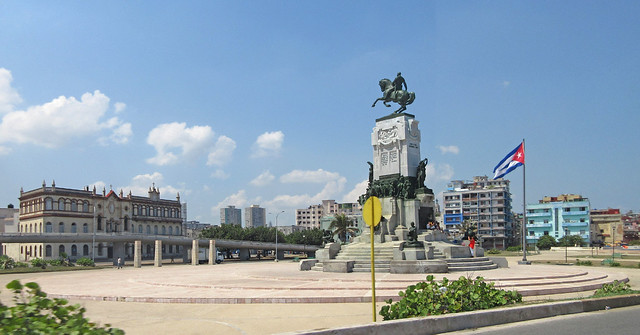

On the opposite side is the Faro Castillo del Morro lighthouse built in 1845 on the ramparts of the Castillo de los Tres Reyes Magos del Morro, an old fortress guarding the harbor of Havana. (Castle of the three Magi Kings of Morro, named after the three biblical Magi.)
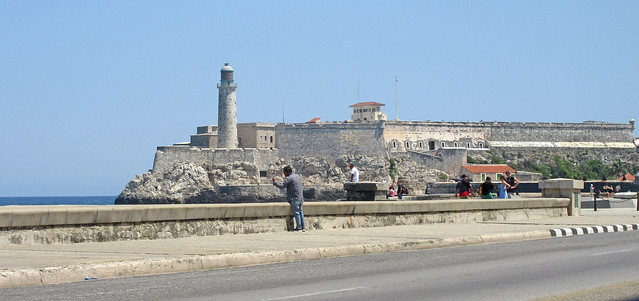
We crossed under the harbor entrance via the Havana Tunnel, built in 1957 and the second wonder of Cuban civil engineering that we have seen this day.
It was a short drive to the top of the hill where we parked and saw the Christ of Havana statue close up and admired the panoramic view of Old Havana.



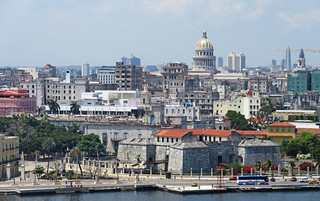

Not far from the statue is the Che Guevara house, now a museum. Constructed during the 1940s as the official office and residence of the chief military officer of the Fortaleza San Carlos de la Cabaña fortress, the house became Guevara's residence in 1959 after the revolution. Upon his death in 1967 it became a museum. Admission is 25 pesos for locals and 200 for foreign visitors.

Both the statue of Christ and the Guevara house are visible from the opposite side of the harbor entrance. Here is the view from from along the waterfront as we near Plaza de Armas.

One last picture that I couldn't resist, based on my final ten years work at Pioneer Power - the Cuban oil refinery on the harbor waterfront.

At this point, Abel had another restaurant suggestion. Just a short distance down the street from the statue parking lot is another paladar - El Cañonazo. There were plenty of old cars out front indicating heavy tourist traffic (it must be exceedingly rare for locals to dine out given the Cuban economics) and we entered through a gate into an elegantly prepared backyard of the home.
Good news: they had Coca-Cola - we had been told it was simply not
available in Cuba. Bad news: meal prices were quite high with entrees
in the 20-25 dollar range. A bit pricey for lunch on this island!

Linda and I both decided to just order the shrimp cocktail which was priced at $9 each. It may have been the food highlight of our trip. We each had at least fifteen good sized fresh shrimp heaped on our plates - and they were not overcooked. I didn't think to take a picture until we were halfway through.

Opinions on this restaurant very greatly on Trip Advisor. They are somewhat more positive on Top-Rated.
One other consideration. At precisely 9:00 p.m., each night, a cannon shot rings out over Havana. The shot comes from a cannon at the nearby Fortress of San Carlos de Cabana, just a hundred and fifty yards away - hence the restaurant name, El Cañonazo (the Cannon Shot.) If you plan to be there for the shot, you will need a reservation.
Notice that the bill is presented in U.S. Dollars as well as other currencies.

And there was a special treat for me, the restaurant has a National Cash Register - calibrated in Pesos and Centavos - so I can use my National Cash Register tag again on this post.

That finished up our day's motor tour so Abel and Luis, the driver, drove us back through the tunnel into Old Havana. As we passed Plaza de San Francisco, Linda was able to catch a photo of the sign for the garden of Mother Teresa which we had not seen on the previous day.

If you would like to see a little more about some of the area discussed in this post, here is an excellent video on YouTube taking you on a ten minute drive along the Malecón and through the tunnel under the harbor entrance.
If you are interested in a thoughtful analysis of what has happened to Cuba over the past 64 years and especially what the future may hold for its residents, you may find this article interesting; I certainly did. It comes from Belmont Freemon, FAIA, a successful New York architect of Cuban descent.
A brief excerpt:
Preserved by poverty, contemporary Havana draws not just culture buffs and architectural enthusiasts but also visitors fascinated to see the ruins of both a magnificent city and the last communist society in the west. Tour promoters play on the time-warp quality of the place, and their clients pose in front of run-down buildings and meticulously maintained 1950s American automobiles and jam the clubs featuring Buena Vista Social Club music. Revolutionary kitsch — Che Guevara T-shirts and rebel berets — fills the souvenir shops. I find it ironic that a socialist government that originally sought to erase history now reaps hard currency by marketing nostalgia — the glamour of pre-revolutionary Havana no less than that that of the early Castro era, when ideals seemed so pure.
...I am weary of hearing people tell me they want to visit Havana “before it changes.” Such sentiment betrays prurient attraction to decay and is at best insensitive to the plight of the Cuban people, who desperately need and deserve change. One way or another, change will come to Cuba.
The distance from Old Havana to Revolution Square is just a bit over three miles. It would be an interesting walk and I encourage visitors to try it.






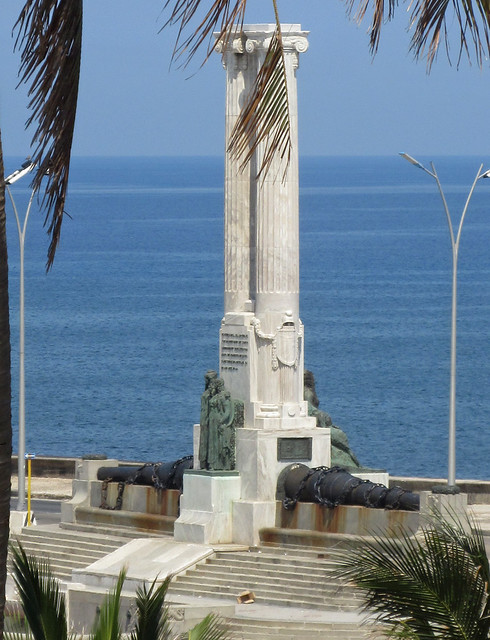






No comments:
Post a Comment